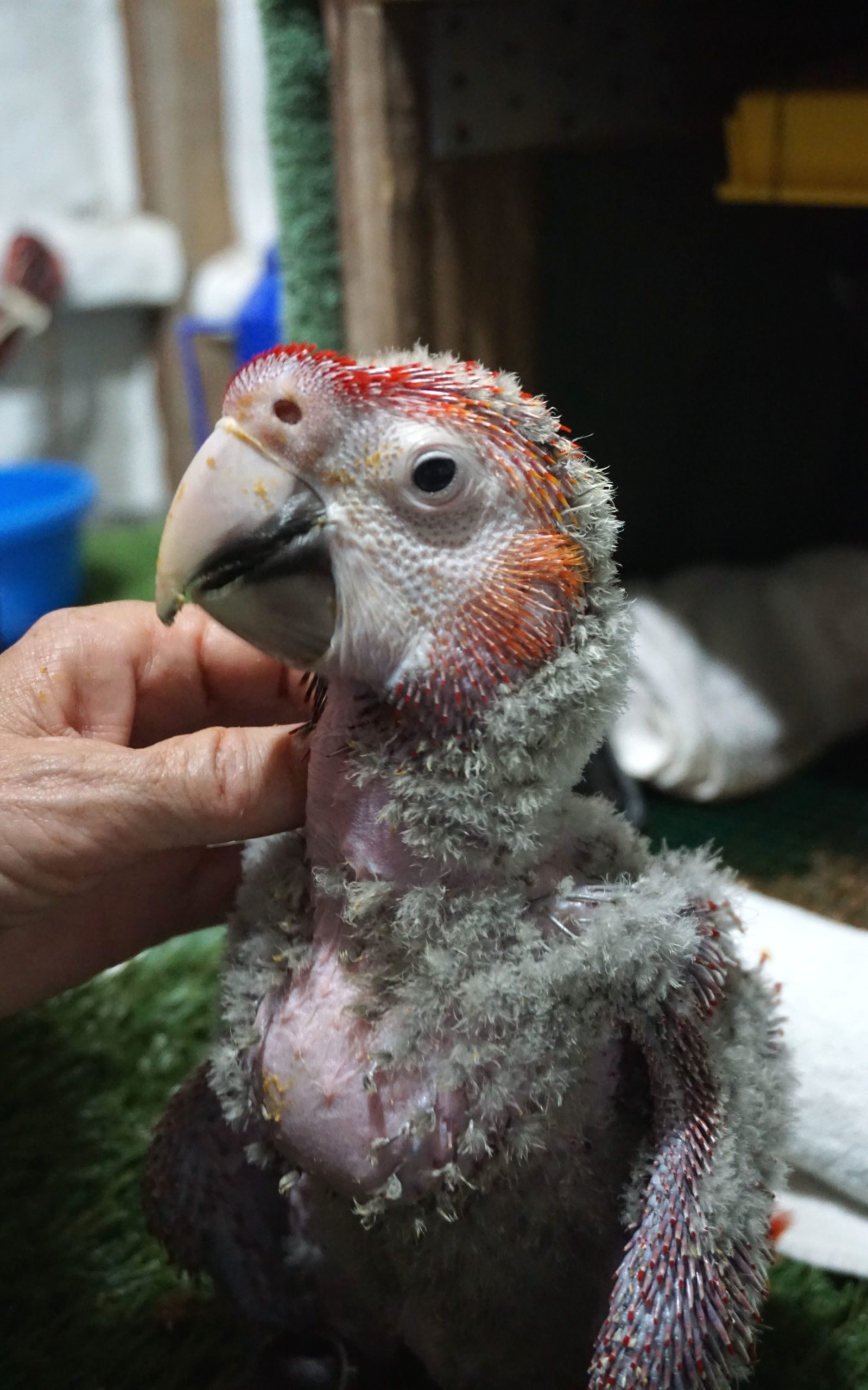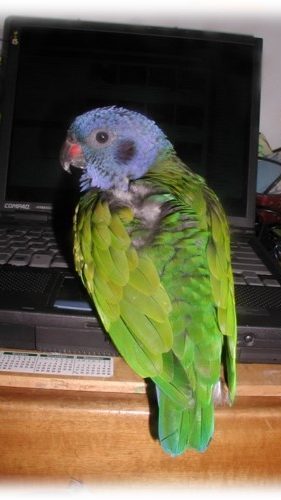Researchers are making progress in the fight to track and treat one of the most common illnesses affecting exotic birds. Proventricular Dilatation Disease, or PDD, is the result of an avian bornavirus infection and is characterized by intestinal paralysis, which results in food becoming stuck in the bird’s proventriculus. The intestine swells, causing discomfort, and when the gut cannot absorb nutrients from the stalled food, the bird dies. Interestingly, not all birds with PDD show these symptoms, and some can live years after exposure to the virus—as many as six or seven—before developing the illness. PDD was once called Macaw Wasting Disease, as it was originally thought just to impact macaws, but we now know it can be found in parrots, finches, lovebirds, quaker parakeets, and cockatiels, as well as wild water fowl such as geese and mute swans.
Scientists have made some headway in their quest to better understand the disease in the past three years. Dr. Ian Tizard, DVM, Ph.D, and director of the Schubot Exotic Bird Health Center at Texas A&M University, has made PDD a career-long focus. Recent progress has provided something of a good news/bad news situation, according to Tizard.
Recent projects have revolved around testing the drugs veterinarians have been using on sick birds to see if they do, in fact, produce appreciable improvement. Many vets use anti-inflammatories to reduce the swelling of the intestine, particularly Celebrex and Meloxicam.
“Our results there have been quite discouraging,” Tizard said. “In our experimentally infected animals, it’s clear that they don’t seem to do much good, and they may be doing some harm.”
Tizard’s hopes for Ribavarin, which A&M researchers begun investigating a few years ago, have begun to fade. Experiments there suggest that Ribavarin does successfully kill PDD in laboratory tissue cultures, but it has not proved as consistent in infected birds. The trick may be correctly timing the medication’s administration.
There is a new drug on the scene, which Tizard is “pinning his hopes on:” cyclosporine, an immunosuppressive drug typically used in humans after organ transplant to prevent rejection. Clinic veterinarians at A&M have used cyclosporine on sick patients with some success, and the first trials with experimentally infected birds will begin at the university this summer.
Part of the difficulty in unearthing a treatment for PDD and ABV comes from the differences between bird and human biology. Birds’ systems metabolize drugs much more quickly than ours do, and seem less susceptible to toxicity. It logically follows that they could need a higher or more frequent dose than their size would sugest to see results, but determining exactly what that dose should be and how often it should be given takes a lot of time.
The other difficulty in fighting PDD and ABV is just that viruses are more challenging to beat than bacterial infections. Viruses are smaller and lack the critical, rigid wall membrane that can make bacteria more vulnerable. Viruses also attach to other cells for replication, making them difficult for drugs to catch … which is why we have relatively few anti-virals compared to antibiotics in the marketplace for human viruses like Ebola or HIV.
Tizard and his colleagues have found that there is one reliable way to avoid the spread of PDD: a good, thorough scrubbing.
“A sort of encouraging bit of news is that if aviary owners use really good hygiene, they can drop the prevalence of the disease very fast—in fact that’s probably the only bit of good news in the PDD area, that hygiene will help. It’s not a very tough virus, but it is shed in large amounts,” he said.
Another strategy that’s been successful in some aviaries is the elimination of healthy carriers of PDD from the breeding group. Most researchers are now confident that PDD can be spread from bird to egg, so stopping it at that source could be effective.
“I do know of some aviary owners who have done that and been quite successful, as long as they at the same time use good hygiene—scrub everything, and are able to separate off positive birds,” Tizard said.
It isn’t necessary to euthanize healthy carriers of the illness—in fact, it’s a big ethical no-no according to Tizard, who pointed out that many birds live their entire lives without becoming ill. Others aren’t so lucky of course, and one of his aims is to figure out when and why that switch is flipped. Texas A&M received a large group of 70 cockatiels a few years back, some of which were healthy carriers and some of which weren’t. The birds are housed together, and Tizard said the whole group is now positive for the virus, but it took 2 years of exposure for the last bird to become infected.
A group at the University of Guelph has looked into occurrence of PDD in water birds. A particularly large die-off of Canada geese was recently traced back to the illness, which makes Tizard think that the birds encountered something together that made the switch from a dormant disease to serious symptoms and death. A&M researchers have concluded, after several tests, that stress does not prompt symptoms, and are now wondering about diet’s impacts on active infection.
Italian researchers have a different theory about the start of the disease’s symptoms. Dr. Giacomo Rossi, professor of general pathology, physiopathology and immunopathology at the University of Camerino, is encouraged by recent research indicating that the disease could be linked to an autoimmune disorder in which the bird’s brain works against itself.
A final area of innovation in recent years has been in the laboratory test for ABV. Texas A&M stopped publicly offering its ABV test of droppings after discovering it could yield a significant amount of false negatives—droppings only contain the virus after it infects the kidneys, which doesn’t happen in all cases. Veterinarians can test blood to hunt for ABV antibodies (a sign the bird has had the virus in its system), but strangely some infected birds don’t make ABV antibodies. The most reliable way to check for ABV remains analysis of brain tissue, which of course isn’t possible with live birds, so experts recommend testing both blood and droppings samples to identify carrier birds.
Fighting viruses is more difficult than fighting bacterial infections, which presents another challenge in the fight against PDD and ABV. Because viruses are smaller and do not have the same hardy outer membrane as bacteria, they can be more vulnerable. Since viruses attach to other cells in order to replicate, they are also difficult for medications to detect. For this reason, the market has a comparatively small number of anti-virals in comparison to antibiotics for human viruses like HIV and Ebola.
Tizard is “pinning his hopes” on cyclosporine, a recently developed immunosuppressive medication that is commonly used in humans following organ transplantation to prevent rejection. veterinarians in the clinic at A
“Our results there have been quite discouraging,” Tizard said. “It’s evident that they don’t appear to do much good in our experimentally infected animals, and they might even be doing some harm.” ”.
Ribavarin’s potential, which A Studies conducted there indicate that ribavarin effectively kills PDD in lab tissue cultures, but its efficacy in infected birds has not been as demonstrated. The trick may be correctly timing the medication’s administration.
Finally, the laboratory test for ABV has seen innovation recently. Texas A Strangely, some infected birds do not produce ABV antibodies. Veterinarians can test blood to look for ABV antibodies, which are a sign the bird has had the virus in its system. Because testing brain tissue is still the most reliable method of detecting ABV in birds—and since this cannot be done on live birds—experts advise testing samples of blood as well as droppings to identify carrier birds.
What are Proventricular Dilation Disease (PDD) and Avian Ganglioneuritis (AG)?
The moniker PDD originates from a clinically recognized early result of avian Bornavirus infection: dilation of the proventriculus, or the area of the stomach between the gizzard and the crop, as well as the proximal small intestine. Food buildup brought on by the digestive system’s partial paralysis is the cause of this dilatation. Dilation of the proventriculus, however, can also be brought on by bacterial enteritis, heavy metal toxicity, foreign bodies, and parasite infections.
Another term for the illness that can develop from an ABV infection is avian ganglioneuritis. Nonetheless, avian ganglioneuritis has happened without an ABV infection. It’s probable that additional infections that raise ganglioside levels could elicit a comparable reaction and lead to PDD/AG development. This has caused controversy regarding the disease’s name because ABV can affect multiple bodily systems, some clinical cases do not exhibit proventricular dilation, and ganglioneuritis can be caused by other illnesses. When discussing diseases caused by ABV infection, the terms PDD, AG, and avian bornaviral ganglioneuritis (ABG) are all used in the literature.
How reliable are the tests for ABV and how do I interpret test results?
It is extremely unlikely for an ABV PCR test to yield a false-positive result. The bird most likely contains ABV if the PCR test comes back positive. But as previously stated, this DOES NOT imply that your bird will become ill.
Interpreting a negative PCR result from a fecal sample or cloacal swab can be more challenging. It indicates that on the day or days the samples were taken, your bird was not shedding the virus. This could be the result of either (A) the virus not infecting your bird or (B) the virus not actively being shed but still being present in the animal. Due to this sporadic shedding, it might be helpful to send several samples for PCR testing to ascertain whether a bird is infected.
You can probably assume your birds are not ABV-positive if they have a long history of good health, are rarely exposed to other birds, and you get negative PCR results. But if your bird exhibits symptoms and you think it might have ABV, speak with your veterinarian about doing further diagnostic testing.
PCR testing and serologic anti-ABV antibody testing yield quite different results. The bird has antibodies against ABV if the antibody test is positive. This implies that the bird developed an immune response after previously being exposed to ABV. It does not, however, indicate whether the birds are afflicted at this time.
A bird lacking antibodies against ABV is indicated by a negative antibody test. However, this could mean two very different things. It’s possible that the bird has never come into contact with or contracted ABV. As an alternative, it’s possible that the bird has contracted ABV but hasn’t yet developed an immunity to the virus. For these reasons, combining different testing techniques could yield a more definitive result regarding your bird’s ABV infection.


Generally speaking, sleepiness, fluffed or rumpled feathers when not cold, and decreased appetite are signs of illness in parrots (Left: Scarlet Macaw chick, Center: Blue-headed Pionus, and Left: Double Yellow-headed Amazon).
FAQ
How do you treat PDD in birds?
What can I feed my bird with PDD?
How long can a bird live with bornavirus?